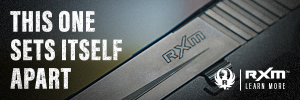On occasion I do a little freelance writing and/or editing work, and the article below is one that I helped create for JK Armament‘s new JK Academy. With firearm suppressor ownership still relatively, let’s say, “unsaturated” among gun owners in general, JK and other manufacturers field a ton of how-to kind of “beginner” questions, and the JK Academy was designed to help with that. In the following article about silencer mounting options, the ins and outs, ups and downs of each are discussed.
Reprinted here with permission from JK Armament:
With literally hundreds of suppressor mounts on the market, it can be difficult to narrow down the right choices for you. In this video we’ll provide a high-level overview and then we’ll cover the JK Armament options.
Most suppressor-ready firearms feature a threaded muzzle, which means there are screw-type threads machined into the business end of the barrel. A suppressor can screw directly onto these barrel threads, or a mount that accepts a suppressor can be installed on the barrel threads.
Let’s briefly cover the four main types of mounting systems: direct thread, quick attach, pistol booster, and 3-Lug:
Direct thread:
If you screw your suppressor directly onto the barrel, that’s called a direct thread mount. JK 105 and 155 series suppressors are compatible with direct thread mounts and some models ship with one. A direct thread mount is the simplest, most straightforward option and it’s also the most budget-friendly option allowing you to move one silencer between multiple guns.
Different calibers have different thread sizes, but one direct thread mount in 1/2×28 size and one in 5/8×24 size will cover a massive list of common calibers from 22 LR to 9mm to 223/5.56 to 308 Winchester, 6.5 Creedmoor, 300 Blackout, and many more.
A direct thread mount stays installed in the base of the suppressor and moves with the suppressor as you move it between firearms. Swap the mount out as necessary to match its thread size with the barrel you’re putting it on.

Quick attach:
With quick attach (QA) systems, also commonly referred to as quick detach (QD) systems, a muzzle device such as a muzzle brake, compensator, or flash hider is securely installed onto the firearm’s threaded barrel and is not intended to be removed.
The outside of this muzzle device interacts with the inside of the mount in the base of the suppressor, and through varying mechanisms allows the suppressor to be attached and removed rapidly. This is the best system for quickly moving a suppressor between multiple rifles or for situations in which the suppressor is removed for transport or storage and then needs to be deployed quickly.
For instance, while a direct thread system may require the suppressor to be turned 20-or-more times in order to screw it down onto the muzzle threads, a QA mount that involves screwing the suppressor on will likely only require 4 or so rotations. Some require as little as a quarter turn.

Pistol booster:
Semi-automatic pistols employing a Browning-style recoil-operated mechanism, which is the vast majority of them (effectively all of them if the barrel isn’t pinned in place, which is more typical of a straight blowback operation), require a pistol booster (AKA a Nielsen Device) if the suppressor weighs more than approximately 4.5 ounces. This is because a suppressor that’s heavier than that impedes the necessary movement of the barrel, which causes the pistol to malfunction.
Inside of a pistol booster is a piston and a spring. When the pistol is fired, the barrel moves and pulls the piston along with it, compressing the spring. The suppressor’s inertia keeps it effectively still during this process. Then, approximately when the pistol’s slide is at the rearmost point in its travel, the booster spring begins pulling the piston and suppressor back together and finishes that process before the pistol’s slide returns all the way forward. It’s now ready for the next shot.
As the piston is the component that screws onto the pistol’s barrel threads, its thread pitch is what has to be matched to the barrel. One pistol booster can be used on pistols of many calibers by swapping the piston out for the correct thread size. In most cases, 9mm pistols are threaded 1/2×28, and .40 cal, 10mm, and 45 ACP pistols are most commonly threaded .578×28.
3-Lug:
A 3-Lug or Tri-Lug system is a QA / QD system used almost exclusively for pistol calibers on fixed barrels. So submachine guns (and semi-automatic variants thereof), PDWs, pistol caliber carbines, etc.
On the firearm side, three lugs are machined into the barrel near the muzzle. On the suppressor side, a 3-Lug adapter is installed into the base of the suppressor and it contains three grooves. Internally there’s a collar with a spring that provides tension on the system and keeps it locked in place.
To install the suppressor, the grooves and lugs are aligned, the suppressor is pushed onto the barrel hard enough to compress the spring inside of the 3-Lug mount, and then it’s rotated approximately 90 degrees clockwise and released. The internal spring pushes the suppressor forward, maintaining pressure against the barrel lugs that keeps them locked into internal recesses. Removing the suppressor involves reversing the process: press it toward the firearm to compress the spring, rotate it counterclockwise until it stops, and pull it off the front.
3-Lug systems are extremely fast and simple to use. Typically speaking they aren’t robust enough and don’t seal up gasses well enough to use them on centerfire rifles, but they’re great on pistol caliber guns.
WARNING: if you use another company’s mount, make sure it’s a quality mount from a trusted manufacturer. Flawless alignment of the suppressor bore with the barrel bore is critical, and small errors in concentricity and manufacturing tolerances in the mount can cause bullets to impact the inside of your suppressor, which can cause catastrophic failure. A bore alignment rod can be used to double check correct alignment prior to shooting. Then again, you could just use JK Armament’s excellent mounting solutions.



